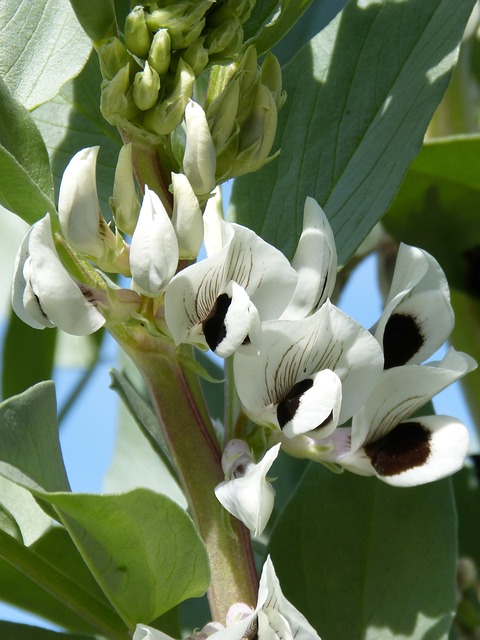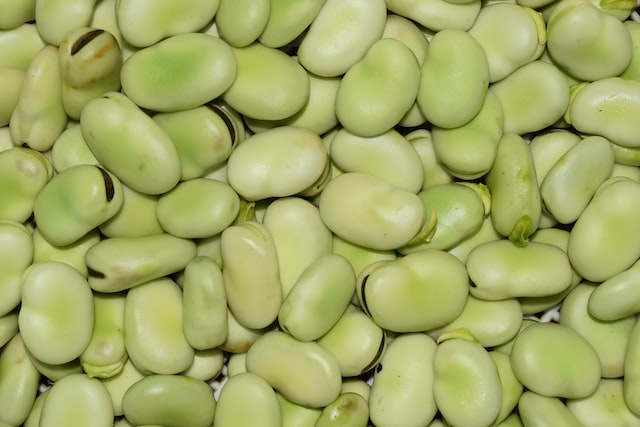Broad beans, or Fava beans as they are also known, are nutritious and hardy beans that can be sown from early spring.
Some varieties can also be sown in October if the soil is reasonably warm and sheltered.
Despite being a resilient plant they can sometimes develop problems causing discoloration and stunted growth.
So if you have asked the question “Why Are My Broad Beans Going Black?” then read on for answers and solutions.
Broad beans are susceptible to three main types of fungus: Broad Bean Rust “Uromyces viciae-fabae”, Botrytis “Chocolate Spot” and Root Rot “Fusarium solani”. They can also suffer from frost damage causing blackening of the leaf tips. Pests such as slugs and blackfly can attack the plant, plus the natural dieback of the flowers and pods can cause discolouration.
Fungus
Broad Bean Rust “Uromyces viciae-fabae”
This is a common fungus that can attack broad beans and other vegetables.
You will be able to see small brown spots surrounded by yellow on the leaves.
There will be a reddish brown dusty residue.
The leaves do not die but can become holey and ragged.
If left untreated the fungus can cover the whole plant.
How to fix:
- If the rust is mainly at the base of the plants but the top flowers and leaves seem OK, try treating the base with Neem Oil as directed on the container.
- Some gardeners also use a diluted milk spray (10% milk to 90% water).
- Remove badly infected leaves and also stems if they have significantly deteriorated.
- Use sterilised tools and sterilise again after use.
- Dispose of (not in the compost heap).
- Prevention is better than a cure so try to keep the base of the plant ventilated and airy by regularly clearing debris.
- Water from the base rather from above to prevent water sitting on the leaves and stems.
Is it safe to eat broad beans with rust on them?
It depends on the extent of the infection. Check inside the pod, if the beans are unaffected and if your pods are only slightly tarnished and haven’t been left on the plant too long then they should be fine to eat. If your pods look very discoloured or cracked then I would not eat them. Either way, don’t re-use them for planting as the fungus can transfer to the next generation.

Botrytis “Chocolate Spot”
This fungus can affect both the foliage, pods, beans and flowers of the broad bean plant.
It occurs when the weather is wet and warm.
You will see lots of small chocolate coloured spots that then join up covering large areas.
Flowers deteriorate and cannot produce viable pods.
Existing pods can split and beans will be discoloured.
If the infection takes hold the plant will turn black and die back.
How to fix:
- Try to prevent major attacks by planting broad beans with sufficient distance between them – 30cm apart is a good spacing.
- This will stop overcrowding and increase good ventilation.
- Monitor irrigation and keep a look out for waterlogged soil as this can contribute to an overly moist environment.
- Improve drainage by digging in some grit before planting.
- Clear debris from around the base of the plants.
- Cut out any infected plant parts and dispose of (not in the compost heap).
- Do not re-use the beans for the next year as the fungus can transfer to the next generation.
Is it safe to eat broad beans with Chocolate Spot on them?
It depends on the extent of the infection. Check inside the pod, if the beans are unaffected and if your pods are only slightly tarnished and haven’t been left on the plant too long then they should be fine to eat. If your pods look very discoloured or cracked then I would not eat them. Either way, don’t re-use them for planting as the fungus can transfer to the next generation.

Root Rot “Fusarium solani”
This type of fungus starts below the ground and can cause damage to the tissue of the roots, which then turn black.
This discolouration can then start to travel up the plant.
Leaves and stems start to turn yellow and die back as the root system begins to fail.
How to fix:
- Rotate the area of planting and do not grow broad beans in the same area in a five year period.
- Break up the soil well before planting.
- Give a good amount of space between plants to aid ventilation. About 30cm is good.
- Avoid overwatering beans and do not allow the soil to become waterlogged and compacted.
- Remove any infected plants making sure to take the full root system too.
- Dispose of (not in the compost heap).
- Sterilise all tools, gloves and hands before and after handling.
Frost Damage
Broad bean plants are very hardy and can withstand temperatures between 0°C and -10°C.
However they can suffer from frost damage in very cold conditions below this level.
This usually shows as a blackening of the leaf tips.
How to fix:
- The good news is that broad beans are usually able to recover well so minimal intervention is needed.
- I would not recommend fleecing them as this can decrease ventilation and increase moisture, both factors in the spread of fungal diseases.
Pests
Slugs
Although broad beans are not a slug’s favourite food, if they have nothing else to eat then they will munch on the new growth.
Leaves and stems will be eaten from the outside in with the edges turning brown to black.
If enough of the plant is eaten it will struggle to survive.
How To Get Rid Of Slugs And Snails:
- There are many gardener’s slug and snail remedies out there but the best remains heading out in the night with a torch and gloves and picking them off.
- Coffee grounds or crushed eggshells spread in the soil around your plants can deter them.
- Encourage natural predators like birds and frogs.
Blackfly
Blackfly are actually a type of aphid that feed on the new growth of broad beans and other plants.
The flowers can be targeted which then affects the new bean pod growth.
Blackfly produce honeydew as a waste product. This sweet substance can stick to the leaves and stems and attract a black sooty mould.
Left untreated blackfly can decimate a plant but they can be treated if spotted early.
How to fix:
- Check plants regularly and if you see a growing infestation then snip off the tips where they congregate.
- Dispose of these (not in the compost heap).
- Affected lower leaves can be wiped with a damp cloth.
- You can use a hose to spray away groups of blackfly on lower stems.
- A mild soap solution with washing up liquid and water can be used to treat the plant.
- Promote biodiversity in your garden and encourage natural predators such as ladybirds. You can relocate any you find in the garden on to the affected plant.
- Plant nasturtiums alongside your broad beans, blackfly like these too and you may succeed in distracting them over to feast on these plants instead.

Natural Process
There are some natural processes that will mean parts of the plant that have finished their work will naturally die back.
If your broad bean plant was looking strong with healthy flowers, but now the flowers have started to go black and die – this could just be that the flowers have done their work and are now fading away to let the pods form.
You may also find that pods that have been left on the plant have dried out and turned black.
Again this is normal, the beans inside will have dried and can be collected for seed.
They can also be cooked once soaked.
Final Thoughts
Broad beans are an excellent choice for a cold season yield.
They are hardy and resilient, and even when affected by the issues above they can recover.
This makes them a perfect plant for beginner gardeners to try.


The leaves on mine are turning black and falling off. But not every plant affected. Could this be due to excessive rain?
This was my first trial with broad beans. Runner beans always do well.
Hi Mike,
It certainly has been far more wet than usual this July and it is possible that the rain is pooling / waterlogging the soil in some areas more than others. Have a look at the soil surrounding the affected bean plants and see if it is wetter than around the non-affected plants. If so, try to redirect accumulating water away using channels, and fill in any dips to try to stop the water pooling around the base of the plants. If the soil has become compacted, loosen it gently to improve aeration.
I hope this helps!
All the best,
Sue